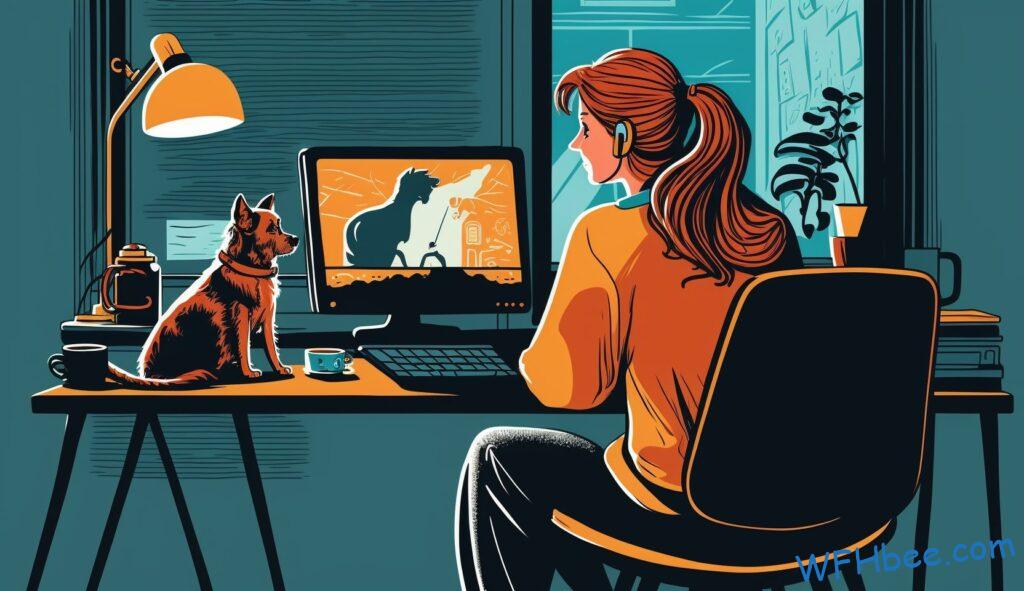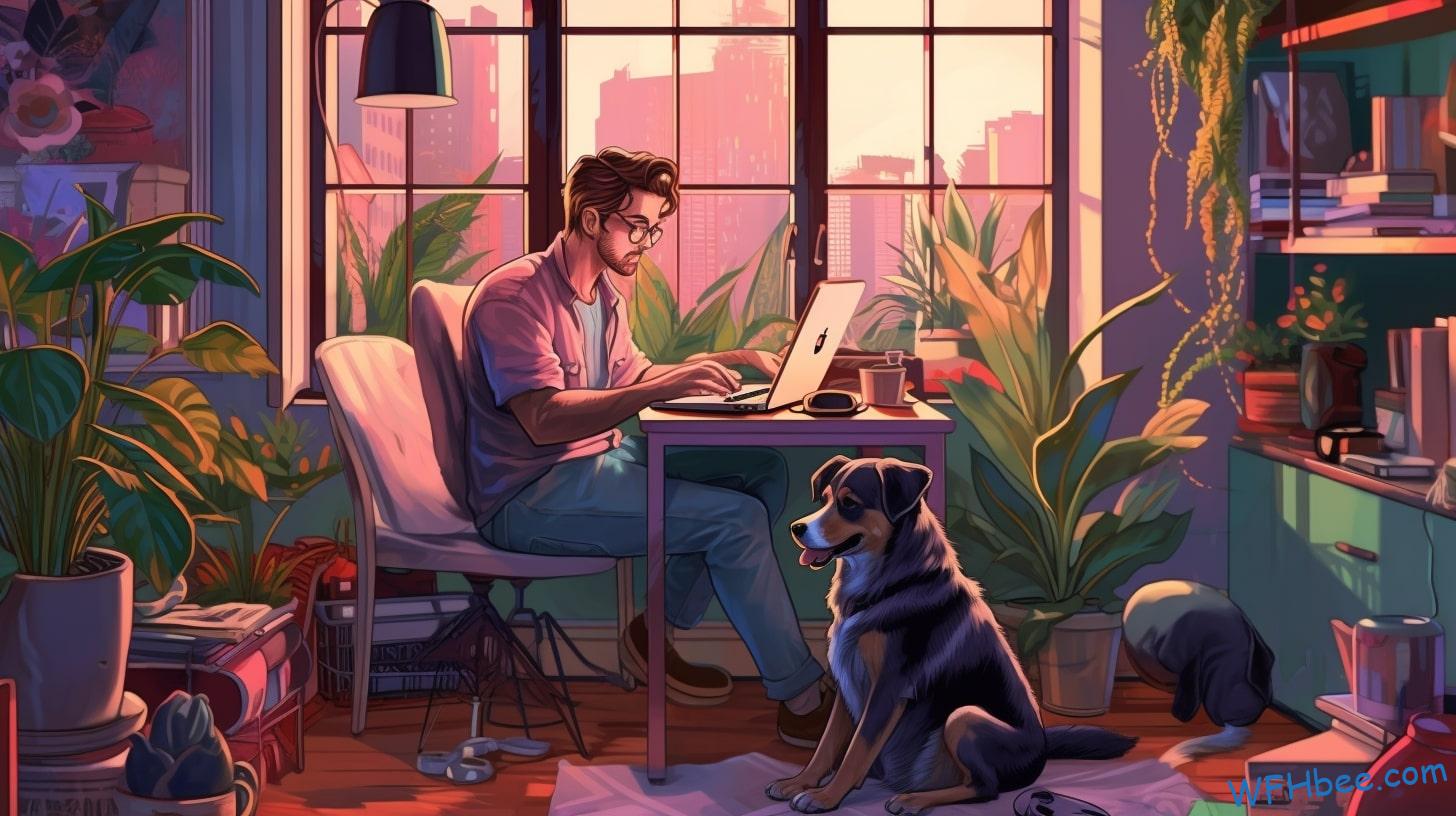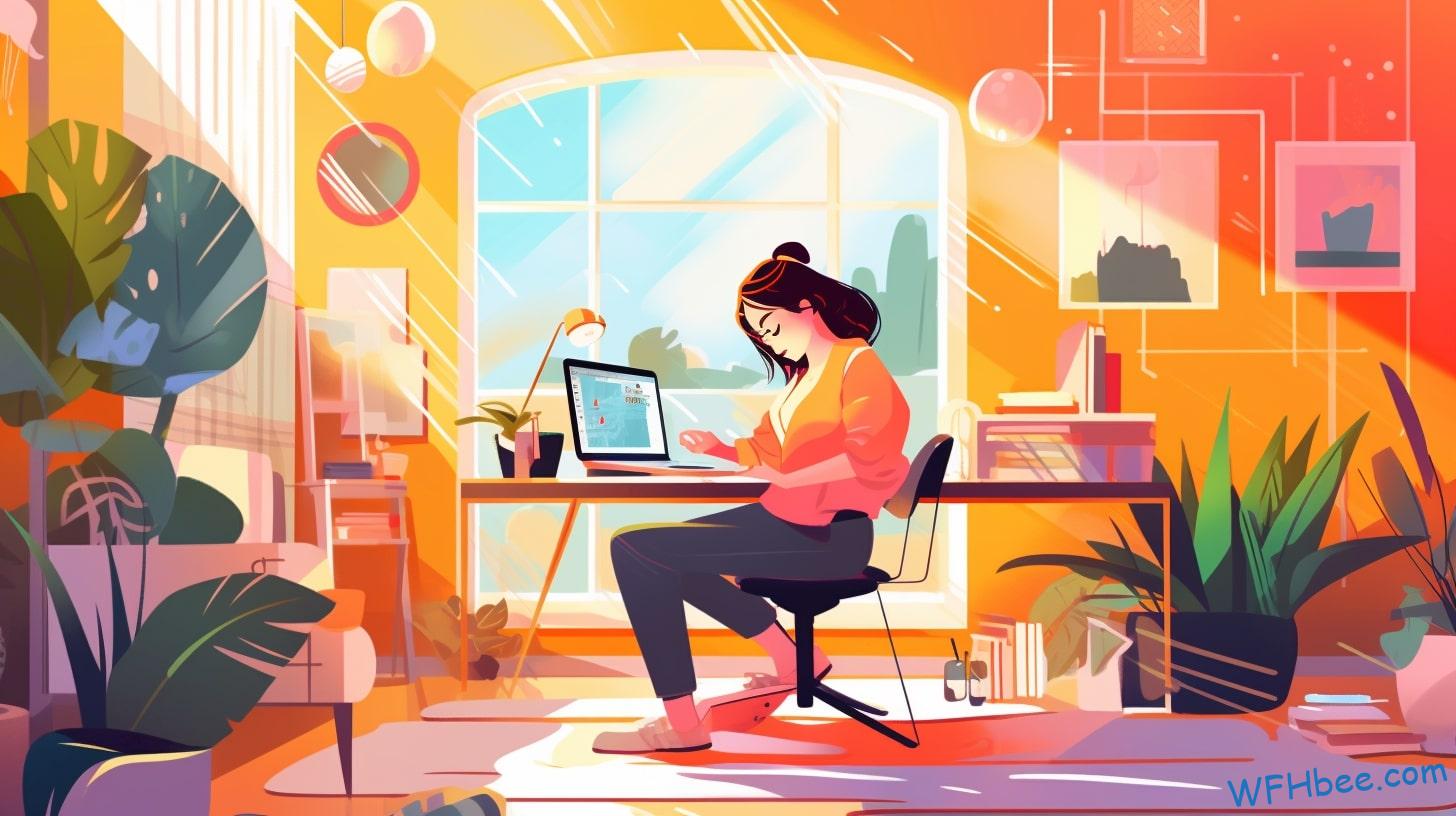Working from home with a puppy can be both exciting and challenging. You get to enjoy the company of your furry friend while working virtually, but distractions abound! But don’t worry – there are plenty of tips that will help make working from home with a puppy easier and more enjoyable for both of you.
Do you feel like you might need some extra support as you transition into “working-from-home-with-a-puppy mode?” If so, then this article is perfect for you. It covers everything from preparing an optimal workspace to creating positive routines that encourage productivity – all tailored specifically to those who want to balance their love of puppies with their desire for freedom.
Ready to learn how to survive when working from home with a pup? Keep reading for practical advice on how to create an environment where everyone (and every pup) wins!
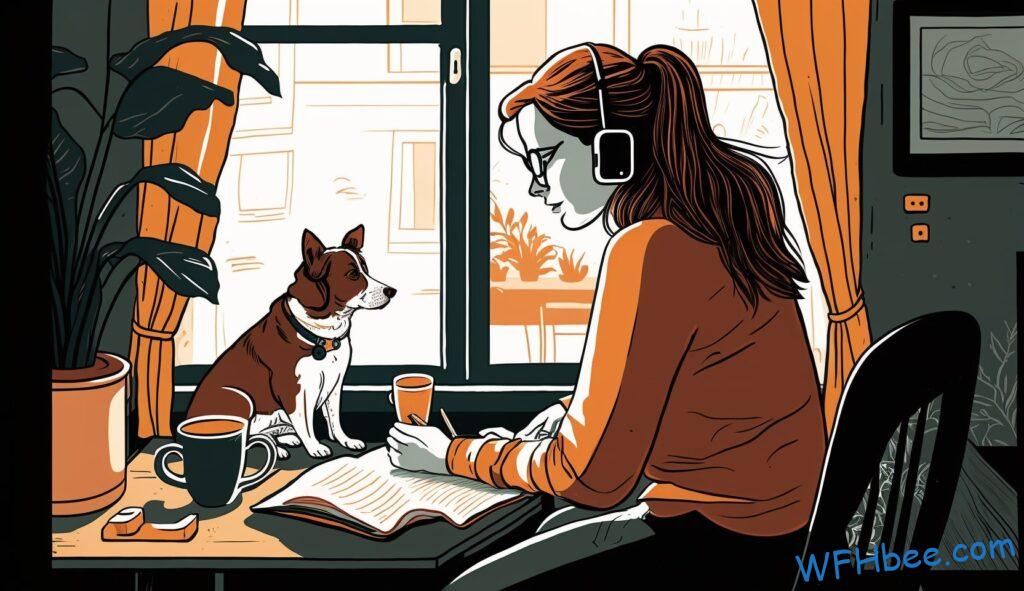
Benefits Of Working With A Puppy
Working with a puppy can be an exciting and rewarding experience. It’s no surprise that having a furry companion nearby while you work from home has many benefits, both mental and physical. Not only do puppies provide companionship in the workplace but they can also boost productivity levels and reduce stress.
Studies have shown that working with a puppy around can actually lead to increased focus, improved cognitive performance, better memory recall, and higher job satisfaction rates. The presence of a pup is said to help promote positive emotions such as happiness and contentment, which can enhance concentration levels for tasks at hand. Additionally, taking regular breaks throughout the day to play or take your pup on walks can give one much-needed mental respite from their workloads.
These four-legged friends not only make great coworkers but are known to bring about greater feelings of calmness and relaxation during times of stress or anxiety. Having a pet by your side when things get overwhelming may even improve overall mood and lighten any negative thoughts brewing in your headspace.
In short, there are numerous advantages to having a puppy alongside you while remote working – if you know how to manage them properly! To ensure success in this arrangement it’s essential to establish some structure…

Also, make sure not to miss our detailed guide on working remotely with dogs (not just puppies)! (Click to read.)
Establishing A Routine
Having a puppy while working from home can be both exciting and challenging. Establishing a routine is essential to ensure that you are able to work without distractions. Having a daily routine will help your pup understand when it’s time for play, potty breaks, walks, eating, and more. It also helps create balance between responsibilities at home and work.
Creating a regular routine schedule with specific times for each activity throughout the day will help establish habits in your pup. For example, if you want them to take their afternoon nap at 1 PM every day, make sure they do so consistently until it becomes part of their normal behavior. This way they won’t expect attention or naps during important meetings or deadlines! Similarly, setting aside special times dedicated solely to playing fetch or having cuddle sessions will help keep things balanced as well.
In addition to creating routines specific to your pup’s needs, incorporating tasks such as cleaning up after meals into your daily schedule promotes orderliness in your living space which is key when trying to stay productive while working from home with an energetic puppy around! With consistent effort and commitment over time, establishing these routines should become second nature for both of you.
With clear expectations set through established routines in place, setting boundaries and rules around behavior becomes much easier – allowing everyone involved to enjoy the experience of working from home with a furry friend by your side!

Setting Boundaries And Rules
Similar to setting up a routine, establishing boundaries and rules for working from home with your puppy is essential. It’s like building a fence around the garden: when done carefully, it creates a safe space that allows both you and your pup to thrive. To get started, here are some tips on how to create these boundaries and rules:
- Set clear expectations for yourself as well as your pet by creating specific commands such as sit, stay or come. This will help ease any confusion about who has control in the house.
- Establish acceptable behaviors for your pup while you work by providing positive reinforcement when they follow the rules and negative feedback when they do not.
- Be consistent with enforcing the boundaries and rules you have set so that your pup can learn what is expected of them quickly.
These three steps should be enough to ensure that everyone stays safe and comfortable while trying to make sure productivity remains high. Creating an environment where both parties feel secure will go a long way towards achieving balance in this unique situation. After all, if everyone knows their place then there shouldn’t be too much disruption during work hours! With these tips in mind, it’s time to move onto ensuring safety and comfort in the workplace for you and your furry companion alike.

Ensuring Safety And Comfort For Your Furry Friend
When it comes to working from home with a puppy, ensuring safety and comfort are paramount. Dog-proofing areas of your home is essential for keeping your pup safe while you’re in work mode. Install baby gates or other barriers at doorways so that they can’t wander into rooms where hazardous objects may be present. A few pet furniture items like an elevated bed and toys specifically made for puppies will help them feel comfortable exploring their new space.
Adding some personal touches such as blankets, treats, and chewable comforts items will make the transition smoother for both you and your furry companion. Having a separate area designed just for playtime can also provide needed physical activity throughout the day. This allows you to dedicate yourself fully to work while still providing enough stimulation to keep them occupied between meetings and emails.
Taking these steps towards safety and comfort creates peace of mind when it comes time to tackle projects during work hours – knowing that your pup won’t get hurt if left unsupervised or become restless due to lack of stimuli. With thoughtful preparation, both you and your furry friend will have all the tools necessary for success in this brave new world of remote work! Moving on, let’s look at how we can puppy-proof our workspace…

Puppy-Proofing Your Workspace At Home
As you consider the logistics of working from home with a puppy, it’s essential to make sure that your workspace is safe and comfortable for both you and your pup. To do so, you’ll need to work on some puppy-proofing.
Visualize yourself in this situation: You’re typing away at your laptop when suddenly, out of nowhere, your furry friend starts chewing on the power cord! Not only can such accidents damage expensive equipment; they can also be dangerous to both humans and animals alike.
To avoid any unfortunate mishaps, take these steps to puppy-proof your workspace:
- Install child-proof locks on drawers or cabinets where hazardous items (such as batteries) are stored.
- Look into pet-safe products like chewable toys and treats specifically designed for puppies – aim for chew-resistant materials if possible.
- Organize cords and wires by bundling them together neatly; not only does this help contain messes but it also prevents tangles which may cause injury or discomfort to a curious pup.
By taking appropriate precautions ahead of time, you can create an environment that will ensure safety while maximizing comfort levels for everyone involved. With all measures taken care of, there’s nothing left now but to explore the next step – providing ample exercise and playtime opportunities for the pup!

Exercise And Playtime For The Puppy
Exercise and playtime are essential for your puppy. It’s important to give them both physical and mental stimulation in order to keep them healthy, happy, and well-behaved. Exercise can be anything from a walk around the block or playing fetch in the yard. Playtime is also great for bonding with your puppy as it gives you time to interact together.
Mental stimulation can include teaching commands such as ‘sit’, ‘stay’ and ‘come’. You could even teach your pup some tricks if you have the patience! Using appropriate treats during training sessions will help reinforce positive behavior. Toys that require problem solving skills like puzzle feeders are another way to provide mental stimulation. Make sure to rotate toys so they don’t get bored with one particular toy after awhile.
Physical activity is just as important when it comes to keeping your puppy active. Playing games of tug-of-war, hide-and-seek or chasing each other around the house can provide hours of entertainment while helping burn off energy too! Providing plenty of chew toys helps satisfy their natural instinctual need to chew on things which keeps them busy instead of finding inappropriate items around the house.
With regular exercise and playtime, not only will your puppy stay physically fit but mentally stimulated as well – leading to fewer behavioral issues down the line. Now let’s look at how providing appropriate treats during training sessions can further help shape good behaviors…

Appropriate Treats For Training
Using treats during training is an effective way to reward your puppy for desired behavior. Training rewards are a crucial part of reinforcing good habits, so it’s important to make sure the snacks you give are healthy and appropriate. Finding the right balance between tasty treats that motivate and nutritional ones can be difficult, but with some research and dedication you will find the perfect training rewards for your pup!
When selecting treats for behavioral reinforcement, consider how long they take to consume. Your puppy should feel rewarded quickly in order to reinforce positive behaviors as soon as possible. You may want to look into smaller, bite-sized pieces or low-calorie options such as air-dried fruits or veggies. If your pup loves meaty snacks, opt for all-natural jerky without any artificial colors or flavors.
For those looking for a healthier alternative, there are plenty of high-quality brands offering specially formulated dog treats packed with vitamins and minerals essential for growth and development. Not only do these treats provide incredible nutrition benefits, but many also contain ingredients specifically designed to promote mental clarity and focus during training sessions. Be sure to read labels closely when shopping around – this will ensure that you’re providing the best quality reinforcement snacks available on the market today!
No matter what type of treat you choose for your furry friend, always keep in mind that puppies have sensitive digestive systems, so start off slow with small portions until their bodies become accustomed to new foods. With a little bit of patience and understanding, you’ll soon discover which types of puppy treats work best for both rewarding progress and encouraging continued success in learning new commands from home!

Minimizing Distractions
Nobody likes to be distracted when they’re trying to get things done. And, as a pet-owner working from home, distractions can come in the form of your furry companions! That’s why it’s important to know how to minimize distractions and keep yourself focused on your work.
One way to avoid distractions is by limiting or preventing access to certain areas in the house where you do not want your dog or other pets getting into trouble. For instance, if you have an office space that serves as both a workspace and bedroom, consider blocking off any entrances with baby gates or closing doors so that your pup doesn’t wander inside while you’re working. Additionally, designate specific areas for playtime and activities such as a backyard or living room – this will help reduce disturbances throughout the day.
Another helpful tip for minimizing distractions is ensuring that all items are properly stored away. Keep cords tucked out of sight and toys tucked away in bins; this will prevent these objects from becoming tripping hazards or sources of curiosity for curious pups! Finally, make sure all food is kept out of reach, too; otherwise your pup might end up snacking instead of napping during nap time!
By following these simple steps, you’ll be able to more effectively manage interruptions from your pet and focus solely on productivity without fear of distraction.
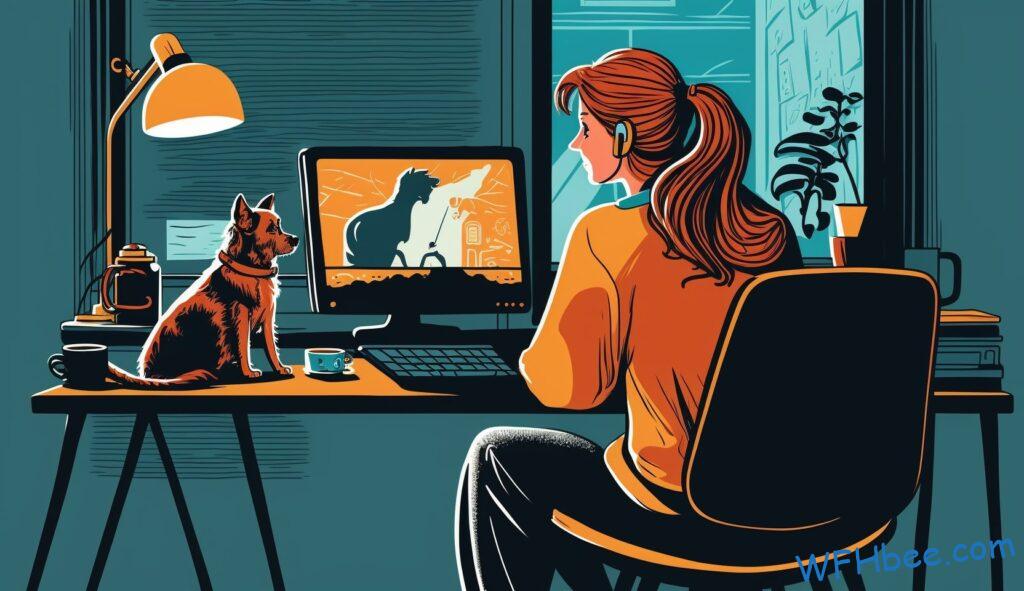
Managing Interruptions From Your Pet
Managing interruptions from your pet is a key element when working from home with a puppy. Although it can be difficult to stay focused on work, there are some tips that you can use to make sure your pup doesn’t distract you too much.
First and foremost, set boundaries for yourself and the pup. Designate an area in your home where he isn’t allowed or keep him off-limits during certain times of day while you’re trying to focus on work tasks. Make sure everyone in the house knows these rules as well so they don’t inadvertently encourage bad behavior.
Another way to manage pet interruptions while working at home is by scheduling playtime into your day. Find activities that keep your pup entertained but also allow you time to get back to work quickly afterwards. If needed, practice leaving the room for short periods of time each day so that she gets used to being alone without feeling anxious about it. This will help her understand the concept of “alone” versus “together” and how those two concepts fit into their daily life together.
These measures should help minimize distractions while still allowing plenty of quality time with your furry friend throughout the day. With careful planning and consistency, soon enough both you and your pup will have adapted nicely to this new routine — making it easier than ever for you both to enjoy all the benefits of having a four legged companion around! Now onto dealing with separation anxiety…

Dealing With Separation Anxiety Of Your Puppy
The last thing anyone wants while working remotely is to feel the loneliness of separation from their beloved pup. As alluring as it may be to have your four-legged companion by your side, dealing with separation anxiety can make or break a work day. But like any challenge, we must persevere and find ways to make this transition successful.
Separation anxiety in puppies can take on many forms ranging from destructive behavior to vocal outbursts when left alone. It’s important for us to recognize these behaviors early so that we can create an environment at home where our puppy learns how to cope without us around. This means having a plan for providing exercise, mental stimulation and consistency in feeding times throughout the day. If possible, keep some toys near the home office space which will help reduce boredom and encourage independent playtime during breaks in between tasks. Additionally, try leaving treats hidden as surprises around the house as positive reinforcement activities when you are away from them.
Another key factor in managing separation anxiety is setting boundaries within the home office workspace including establishing no-go areas or places off limits such as desks or furniture pieces that contains items used during business hours only. This helps pets understand what they should not touch while also creating a sense of safety if they need quiet time away from distractions – whether human or canine! Lastly, set aside time each week specifically for socialization which includes walks outside or even trips to the park nearby; this way, both you and your pet enjoy quality bonding time together after long days spent apart.
By being proactive with developing these strategies ahead of time, working remotely with a puppy doesn’t have to be an impossible situation – but rather an opportunity for growth and learning for both parties involved! With patience and understanding, everyone can benefit from finding balance between professional demands and personal fulfillment through companionship with our furry friends.
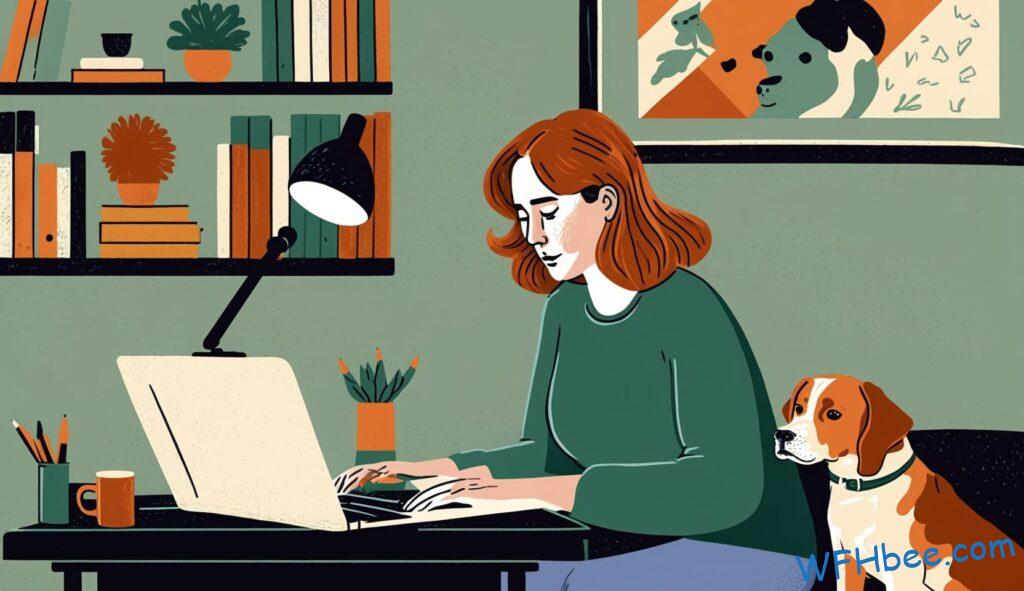
Making Time For Socialization
Working from home with a puppy can result in a lot of distractions. It’s important to remember that your pup needs regular socialization, even if you don’t have the same access to other people and animals as before. Socializing puppies is essential for their development, so it’s worth taking the time out of your day to build relationships with others.
The benefits of pet socialization are countless. Not only does it help them learn how to interact with different kinds of people and animals, but it also helps them become more confident and relaxed when engaging in new environments. Additionally, positive experiences during puppyhood will reduce fears and anxieties later on in life. Allowing your dog enough opportunities to meet new friends will ensure they grow up well-adjusted and happy.
There are many activities that you can do at home or outside (following safety guidelines) to give your pup plenty of chances for puppy socialization. You could take them on walks around the neighborhood or set up playdates with friendly neighbors who own dogs too! Or try having fun sessions indoors playing games like hide-and-seek or fetch; teaching basic commands; providing chew toys; introducing novel environmental changes such as sounds, smells, sights; and offering treats upon completion of tasks correctly.
Socializing puppies early on has numerous advantages, so make sure you provide ample opportunities for these valuable interactions while working from home – your furry friend will thank you later! Now let’s talk about addressing behavioral issues quickly…

Addressing Behavioral Issues Quickly
Living with a puppy while working from home can be a challenge. According to experts, the average puppy needs up to four hours of exercise every day. This may seem like too much time when one is trying to work and keep up with other responsibilities at home. However, it’s important that any behavioral issues are addressed quickly before they become more difficult problems later on.
One way to address these types of issues is through positive training techniques such as clicker training or reward-based methods. These strategies help puppies learn how to behave in different situations by providing them with rewards for good behavior rather than punishing bad behavior. Clicker training also helps owners better understand their pup’s body language so they can correct behaviors earlier on and resolve issues quicker. Additionally, pet parents should consistently use commands and phrases; this will create consistency and make sure your pup knows which behaviors are expected of him/her.
It’s important for pet owners to recognize when their own patience has run out because addressing behavioral issues requires dedication and commitment from both the owner and the pup! If an issue persists after repeated efforts have been made, seeking professional help from a qualified animal trainer or canine behaviorist might be necessary. Understanding what triggers certain reactions in your puppy can go a long way in preventing future incidents – ultimately leading to a stress-free living environment where everyone involved feels comfortable and happy!

Seeking Professional Help If Necessary
When working from home with a pup, it’s important to remember that sometimes professional help is necessary. If your puppy has separation anxiety, or any other behavioral issues, getting the right advice can be crucial. Here are some tips for seeking professional help:
- Start by researching different kinds of professionals who specialize in puppy behavior and development. Veterinarians, dog trainers, pet behaviorists – each one has their own skillset and expertise to offer.
- Seek out reviews from friends who have been through similar experiences before settling on the best option for you and your pup’s needs.
- Set up an appointment as soon as possible so that you can get started on creating positive changes in your pup’s environment and routine.
- Be prepared to discuss details about your pup’s age, diet, exercise schedule and personality so that they can tailor their advice specifically to his or her needs.
Having access to qualified professionals will not only reduce stress but also make sure that both you and your pup are being given the care needed to create a safe and happy lifestyle together at home! Working with them will ensure that you’re taking all the steps necessary to address any potential issues quickly and efficiently – leaving more time for quality bonding moments between you two!

Balancing Work With Quality Time
Balancing work with quality time is like walking a tightrope – it takes practice and skill to navigate. Whether you have a puppy at home or not, achieving the right balance between your professional commitments and your personal life can be challenging. But having a furry companion in the house adds an extra layer of complexity that requires special attention. To ensure both you and your pup are getting enough rest, love, and playtime while still remaining productive during working hours, here are some tips for successfully managing a work-life balance when you’re stuck inside with man’s best friend.
First off, make sure to set aside specific times throughout each day dedicated solely to puppy time. This could include early morning walks before starting work, regular breaks for petting and playing games together during lunch hour, and evening strolls around the block after dinner – whatever works best for you both! Not only will this help create a sense of routine for your pup (which helps them stay calm), but spending quality time with them whenever possible provides stress relief from overwhelming workloads that many remote workers experience on a daily basis.
Furthermore, if things become too much or distractions start spiraling out of control while trying to get through tasks at hand, take mini breaks away from your desk or workspace as often as needed without feeling guilty about it. Allowing yourself moments of relaxation every now and then helps reduce anxiety levels so that productivity doesn’t suffer over long periods of time. So whether it’s going outside for fresh air with Fido or taking five minutes to meditate indoors by yourself, finding ways to recharge should always remain top priority even when juggling multiple responsibilities simultaneously.
These simple strategies all contribute towards creating an environment where everyone involved feels secure and contented—from your boss who expects results on deadlines to the four-legged pal begging for belly rubs nonstop! With these suggestions in mind, hopefully transitioning into working remotely with our canine friends won’t seem as daunting anymore. Taking breaks to recharge might just be the key ingredient necessary for success!

Taking Breaks To Recharge
It’s easy to get absorbed in work when you’re at home with your puppy, but taking breaks is essential for maintaining productivity and sanity. Taking regular breaks from work can help recharge energy levels, refresh the mind and reduce stress.
Exercise breaks are an excellent way of releasing endorphins and calming the body down. Whether it’s a quick walk around the block or some stretches done inside on a yoga mat, exercise helps break up long periods of sitting while providing physical benefits as well. Even if you only have five minutes, make sure that you take time throughout the day to move your body and increase blood flow.
Spending time away from technology also gives our minds a chance to reset and refocus without distraction. This could mean reading a book or magazine, engaging in meaningful conversation with loved ones, or just being mindful of nature by going outside in search of fresh air – all activities which will provide much needed relief from screen overload! Without these moments of respite during the working day we may struggle to stay productive over longer periods of time so it’s important not to underestimate their value.
These ideas might seem simple enough but they can be powerful tools for reducing stress and increasing focus – two things that are very important when working from home with a puppy! So remember: take regular breaks throughout the day for yourself; your mind will thank you later!

Conclusion
Working from home with a puppy has its challenges, but with the right routine and safety measures in place, it can be an enriching experience for both you and your pet. Repetition is key when training your pup to adapt to their new environment, as consistency will help them learn what’s expected of them. Once they understand boundaries and rules, you can create a safe workspace that allows you to work without distractions while still providing quality time together. Lastly, don’t forget to take breaks throughout the day so that both of you stay healthy and energized.
For those who are afraid of taking on such a responsibility due to lack of experience or other concerns – fear not! With patience and dedication, anyone can make working from home with a puppy successful if they’re willing to put in the effort needed. So go forth: grab some treats, cuddle up with your pup, and enjoy this unique opportunity to bond even further over shared experiences.
Remember: It may seem overwhelming at first but with consistent effort and positive reinforcement, you’ll soon be reaping all the benefits that come along with having a furry companion by your side during these unprecedented times.
Author: Robin Borg
Hi, I’m Robin. I have been working from home at least one day a week during all of my adult life. I have a background in research and data science. Get to know me better in the About page.

